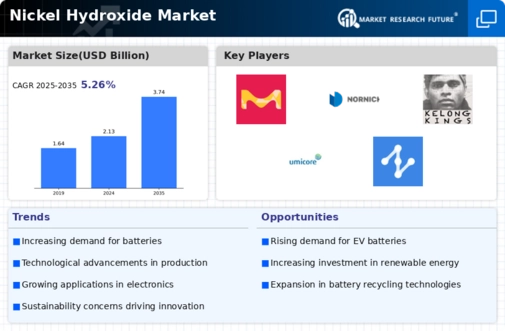Market Analysis
In-depth Analysis of Nickel Hydroxide Market Industry Landscape
Nickel possesses remarkable qualities, including exceptional ductility, corrosion resistance, and hardness, making it an ideal choice for electroplating metal surfaces. The process of electro nickel plating not only enhances the brightness and overall appearance of a product but also allows for diverse finishes such as matte, pearl, satin, semi-bright, and completely bright, catering to various aesthetic preferences.
This electroplating technique is widely employed in diverse industries, including consumer electronics, furniture manufacturing, and aircraft production. The versatility of nickel electroplating lies in its ability to impart numerous benefits to coated surfaces. These advantages encompass increased resistance to corrosion, enhanced hardness, superior strength, resistance to wear, and improved ductility.
One notable application of nickel electroplating is in the field of consumer electronics, where it plays a crucial role in ensuring the durability and aesthetic appeal of electronic devices. The process creates a highly conductive surface with notable corrosion resistance and solderability, making it particularly well-suited for electronic components like printed circuit boards (PCBs), microprocessors, and connectors.
In the realm of PCB circuits, nickel plating serves as a key element in enhancing reliability and functionality. It provides a conductive surface that facilitates soldering, ensuring secure connections within the electronic circuitry. The electronics industry heavily relies on nickel plating for components such as connectors, contacts, microprocessors, and integrated circuits due to the stringent specifications these elements require.
For instance, the corrosion resistance offered by nickel plating is crucial in preventing degradation over time, ensuring the longevity and reliability of electronic components. Additionally, nickel plating acts as a barrier layer, preventing the migration of metals into copper, a vital aspect in maintaining the integrity of the circuit. It also serves as a preventive measure against the formation of "whiskers," minute protrusions that could potentially lead to short circuits.
In electronic applications, electroless nickel plating is frequently used in conjunction with an additional layer of gold, providing added protection against corrosion. This combination is commonly employed in printed circuit boards, where the gold layer further safeguards the components from environmental factors.
Beyond its applications in electronics, nickel hydroxide extends its utility to various processes, including photocatalysis, electrocatalysis, and electrosynthesis, showcasing the diverse range of functions nickel compounds can fulfill.
Moreover, in scenarios where surfaces endure heavy wear, such as switch contacts, contacts, or plug gold, nickel is utilized as the substrate coating for gold. This combination significantly enhances wear resistance, ensuring the durability of these components.
In essence, nickel's role in electroplating goes beyond mere aesthetics, extending into the realms of functionality, reliability, and longevity, making it an indispensable element in various industries where the demands for performance and durability are high. Whether in consumer electronics or aircraft manufacturing, the versatile properties of nickel contribute significantly to the quality and longevity of diverse products and components.








Leave a Comment